Regimental
History: 1863 (continued)
 fter a day's rest, the 28th Massachusetts
rushed with the rest of its brigade and corps into Pennsylvania, where
the beleaguered leading elements of the Union army had become engaged
just north of Gettysburg. But the 2nd Corps arrived too late to be of
any help in the savage fighting that took place on July 1.
fter a day's rest, the 28th Massachusetts
rushed with the rest of its brigade and corps into Pennsylvania, where
the beleaguered leading elements of the Union army had become engaged
just north of Gettysburg. But the 2nd Corps arrived too late to be of
any help in the savage fighting that took place on July 1.
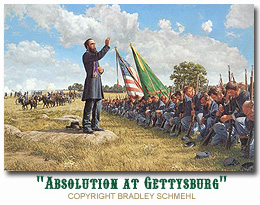 On
the morning of July 2, the 28th Massachusetts was positioned near the
center of the Union line along the crest of Cemetery Ridge, waiting in
reserve well into the afternoon. Then, Maj. Gen. Hancock ordered
Caldwell's 1st Division, which included the Irish Brigade, to form up
and reinforce the faltering left end of the federal line. Before the
advance, Father William Corby, the brigade's chaplain, stood on a rock
and pronounced general absolution to the Irishmen kneeling around him.
On
the morning of July 2, the 28th Massachusetts was positioned near the
center of the Union line along the crest of Cemetery Ridge, waiting in
reserve well into the afternoon. Then, Maj. Gen. Hancock ordered
Caldwell's 1st Division, which included the Irish Brigade, to form up
and reinforce the faltering left end of the federal line. Before the
advance, Father William Corby, the brigade's chaplain, stood on a rock
and pronounced general absolution to the Irishmen kneeling around him.
Just moments later, the 28th Massachusetts
and the rest of the Irish Brigade charged first into the Wheatfield,
and then into a forested area beyond it known as the Stony Knoll. The
rapid advance took the Confederates by surprise, with the Irish taking
a large number of prisoners. Those rebels not captured fled into the
woods and to the Rose Farm beyond. This was an important attack because
it helped repel a Confederate assault that was poised to overwhelm the
entire Union position. Before its men could celebrate a hard-won
victory, however, the Irish Brigade was flanked on the right by
Confederate reinforcements who had broken through in the Peach Orchard.
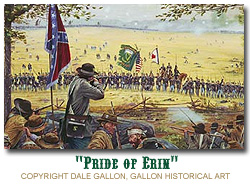 Facing
imminent capture, Col. Byrnes picked up the regimental colors and
coolly led his men back through the blood-soaked Wheatfield, all the
while ordering them to fire volleys at the rebels in pursuit. During
the charge and subsequent repulse, the 28th Massachusetts lost 107 men
- nearly half of the 224 it had brought into the battle. Many were
wounded and left on the field to be captured during the retreat.
Facing
imminent capture, Col. Byrnes picked up the regimental colors and
coolly led his men back through the blood-soaked Wheatfield, all the
while ordering them to fire volleys at the rebels in pursuit. During
the charge and subsequent repulse, the 28th Massachusetts lost 107 men
- nearly half of the 224 it had brought into the battle. Many were
wounded and left on the field to be captured during the retreat.
What remained of the Irish Brigade was
ordered back to Cemetery Ridge for the night. Upon returning to their
original position, the men of the 28th Massachusetts went to work
building rough breastworks of rocks and fence rails. There they
remained on the morning of July 3, trading occasional shots with rebel
pickets while awaiting Gen. Lee's next move.
Suddenly, the ominous stillness was broken
with a barrage of Confederate artillery fire on the federal positions
along Cemetery Ridge. Although the air was filled with projectiles,
most of them flew well over the heads of the Irish, landing on the
higher points of the ridge behind them. A few men in the 28th
Massachusetts suffered minor wounds. When the cannonade stopped, the
Confederate advance that came to be known as Pickett's Charge began.
The rebel objective was the center of the 2nd Corps position, more than
a mile to the right of the Irish Brigade. In spite of the distance, the
men of the 28th managed to fire a number of long-range volleys at the
passing rebel troops and brought in prisoners who surrendered near
their lines.
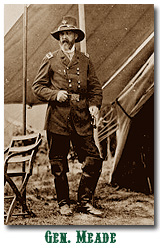 Four days after the repulse of Pickett's
Charge and two after the Confederates withdrew from Gettysburg, the
Irish Brigade remained in position on Cemetery Ridge, seeking to locate
and bury its dead. While the battle had ended in significant Union
victory, Meade opted against immediate pursuit of Lee's retreating
rebel army to give his own forces time to recuperate, but would soon
renew the offensive toward Richmond.
Four days after the repulse of Pickett's
Charge and two after the Confederates withdrew from Gettysburg, the
Irish Brigade remained in position on Cemetery Ridge, seeking to locate
and bury its dead. While the battle had ended in significant Union
victory, Meade opted against immediate pursuit of Lee's retreating
rebel army to give his own forces time to recuperate, but would soon
renew the offensive toward Richmond.
The 28th Massachusetts left Gettysburg on
July 7, marching through Taneytown and Frederick, Maryland, over the
next two days, crossing South Mountain at Crampton's Gap on July 10,
and reached Falling Waters opposite Harper's Ferry on July 15. From
there, the Irish crossed the Potomac into Virginia on July 18, and
marched south through Snicker's Gap, Bloomfield and Ashby's Gap,
arriving at Manassas Gap by July 24. From there, there was another week
of exhausting marches across the Virginia countryside. The regiment
finally went into camp at Morrisville on July 31 and would remain there
for an entire month to rest and refit. The 28th marched on the final
day of August to U.S. Ford in support of a cavalry action, but returned
to camp less than a week later.
On September 10, the much-depleted ranks of
the regiment were partially restored to more than 300 men with the
addition of 175 draftees from Massachusetts. Some of these men would
prove to be good soldiers, but many were reluctant fighters and a
number were completely opposed to the war. Desertions had always
plagued the regiment, but now they would multiply with the prospect of
long forced marches and frequent skirmishes ahead.
The 28th Massachusetts left camp again two
days later, marching via Culpepper to Rapidan Station by September 17.
There, the Irish were assigned picket duty, and remained on the lines
until October 6, when they moved back toward Culpepper. On October 12
at Auburn Hill, enemy shelling forced the regiment to retreat. The 28th
skirmished with its Confederate pursuers along the route, suffering six
casualties, and Brig. Gen. John Caldwell reported that "the men showed
but little confusion, and kept their ranks while moving around the
hill, the conscripts moving nearly as steady as old soldiers."
 Acting as the Union army's rear guard,
the 28th Massachusetts continued through Catlett's Station, and
arriving back at Bristoe Station joined the main body of the 2nd Corps
along a railroad embankment, once again enduring heavy artillery fire.
After the bombardment, Gen. Lee ordered several divisions forward to
attack the Union line, but they were easily repulsed. The rebels
suffered heavy casualties; the 28th none.
Acting as the Union army's rear guard,
the 28th Massachusetts continued through Catlett's Station, and
arriving back at Bristoe Station joined the main body of the 2nd Corps
along a railroad embankment, once again enduring heavy artillery fire.
After the bombardment, Gen. Lee ordered several divisions forward to
attack the Union line, but they were easily repulsed. The rebels
suffered heavy casualties; the 28th none.
The Irish remained in and around the
vicinity of Manassas and Warrenton until October 23, when they moved
back toward the Rappahannock, finally crossing the river at Kelly's
Ford on November 7. The regiment established camp at Shackleford's
Farm, where they remained for nearly three weeks, many believing that
they would stay for the winter. But on November 26, they were ordered
out of camp to cross the Rapidan River at Germania Ford and begin what
would become known as the Mine Run campaign.
Moving forward with the 2nd Corps on the
November 29, the men of the 28th Massachusetts were deployed as
skirmishers, their left flank on the Plank Road near Robinson's Tavern.
Ordered to charge, the Irish drove the rebels they faced from their
rifle pits, capturing prisoners and scattering all opposition before
them. Col. Byrnes' men moved so quickly that reached the crest of a
hill well before the rest of the 2nd Corps did, losing nine men in the
process. There, they were halted to await the arrival of the other
regiments and prepare for the attack Gen. Meade planned to launch early
the next morning. But when he discovered that the Confederates had
strengthened their works and brought in reinforcements overnight, the
federal command called off the assault and his army withdrew across the
Rapidan to Brandy Station.
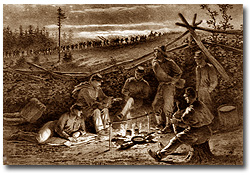 On December 5, the 28th Massachusetts
arrived at Stevensburg, Virginia, where it established winter quarters.
Except for an early February reconnaissance to the Rapidan, the
regiment would not see action again until the Union Army, under the
overall direction of Gen. Ulysses S. Grant, began its relentless and
bloody Overland Campaign six months later.
On December 5, the 28th Massachusetts
arrived at Stevensburg, Virginia, where it established winter quarters.
Except for an early February reconnaissance to the Rapidan, the
regiment would not see action again until the Union Army, under the
overall direction of Gen. Ulysses S. Grant, began its relentless and
bloody Overland Campaign six months later.
By the end of 1863, year the Union high
command realized that the enlistments of many veteran regiments would
expire by the middle of the following year. This would have dire
consequences for the federal war effort, so Congress was compelled to
act. It first authorized existing units to continue as "veteran
volunteer regiments" if they were able to re-enlist two-thirds of their
men. Units falling short of these numbers would be disbanded when their
terms ran out.
To induce soldiers to re-enlist with their regiments, the federal
government offered them 30-day furloughs and cash payments of $402. The
Commonwealth of Massachusetts, meanwhile, offered $325 over and above
the federal incentive to all of veterans who re-enlisted by January 1,
1864. Whether it was their patriotism, a sense of
imminent victory, or the prospect of receiving what was then a huge sum
of money, 157 veterans who had signed on with the 28th Massachusetts in
late 1861 and early 1862 re-enlisted.
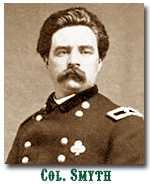 An
additional incentive may have been the welcome news that Col. Thomas A.
Smyth, formerly of the 1st Delaware Infantry, had been selected to
command the Irish Brigade. Smyth was a fellow Irish immigrant who had
won plaudits as a brigade commander in the 2nd Corps for "bravery
almost amounting to rashness." Although he was a strict disciplinarian,
he was ever attentive to the needs of his men, and never stayed in the
rear for long when they became engaged with the enemy.
An
additional incentive may have been the welcome news that Col. Thomas A.
Smyth, formerly of the 1st Delaware Infantry, had been selected to
command the Irish Brigade. Smyth was a fellow Irish immigrant who had
won plaudits as a brigade commander in the 2nd Corps for "bravery
almost amounting to rashness." Although he was a strict disciplinarian,
he was ever attentive to the needs of his men, and never stayed in the
rear for long when they became engaged with the enemy.
Continued
>

